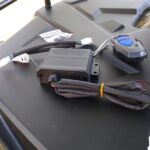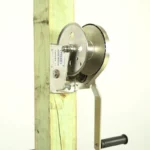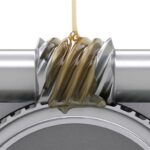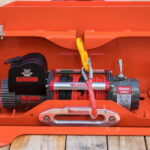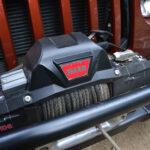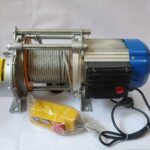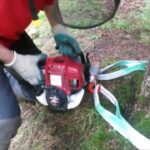Winches have been an indispensable tool in various industries for centuries, enabling the lifting, pulling, or lowering of heavy loads. Among the different types of winches available, worm gear winches stand out due to their unique features and versatility. In this article, we will explore the components of a worm gear winch, how they work, their applications, and tips on selecting the right winch for your needs. We will also cover maintenance and safety tips to ensure optimal performance and longevity of your worm gear winch.
Components of a Worm Gear Winch
A worm gear winch consists of several key components that work together to perform its tasks:
Worm Gear
The worm gear is a helical gear with a screw-like shape, which meshes with the worm shaft. This gear is responsible for converting rotational motion from the worm shaft into linear motion to pull or lower loads.
Worm Shaft
The worm shaft is a threaded rod that drives the worm gear. It is turned by either a crank handle or a motor, providing the input rotation for the winch.
Drum
The drum is a cylindrical component that winds or unwinds the cable or rope as the worm gear turns. It is responsible for lifting or lowering the load connected to the winch.
Crank Handle or Motor
A worm gear winch can be operated manually by a crank handle or powered by an electric or hydraulic motor. The choice of power source depends on the intended application and the user’s preferences.
You may want to read how to use a hand crank winch
Brake System
The brake system is an essential safety feature in worm gear winches. It prevents the winch drum from rotating unintentionally and keeps the load securely in place when the winch is not in operation.
How Does a Worm Gear Winch Work?
The Principle of Operation
A worm gear winch operates by converting rotational motion into linear motion through the interaction of the worm shaft and the worm gear. This conversion takes place in two stages:
Rotational Motion
The rotational motion starts when the worm shaft is turned by the crank handle or motor. This motion is transferred to the worm gear, which meshes with the worm shaft.
Linear Motion
As the worm gear turns, it causes the drum to rotate. This rotation winds or unwinds the cable or rope around the drum, creating linear motion that lifts or lowers the connected load.
Step-by-Step Explanation of the Working Process
Step 1: Input Rotation: The winch operation begins with the rotation of the worm shaft, either manually by a crank handle or powered by a motor.
Step 2: Gear Reduction: The worm shaft’s rotation is transferred to the worm gear, which provides gear reduction. This reduction increases the torque and decreases the speed, resulting in controlled and powerful linear motion.
Step 3: Drum Rotation: As the worm gear turns, it causes the drum to rotate. The direction of the drum’s rotation depends on the direction of the input rotation, allowing the user to lift or lower loads as needed.
Step 4: Cable Winding or Unwinding: The cable or rope wound around the drum is pulled in or let out as the drum rotates, creating the linear motion that lifts or lowers the load.
Step 5: Load Lifting or Lowering: With the cable winding or unwinding, the load connected to the winch is lifted or lowered as desired.
Self-Locking Feature
How it Works ?
The self-locking feature in worm gear[1] winches is an inherent property of the worm gear mechanism. Due to the high gear reduction and the angle of the worm gear’s helix, the worm shaft cannot be driven by the worm gear. This prevents the drum from rotating backward under load, effectively locking the winch in place when not in operation.
Advantages of Self-Locking
The self-locking feature provides several benefits, including increased safety and better load control. It ensures that the load remains securely in place when the winch is not in use, eliminating the need for an external brake system. Moreover, it allows for precise positioning of the load, making it ideal for applications that require accuracy and stability.
Worm Gear Winch Maintenance and Safety Tips
Proper maintenance and adherence to safety guidelines are crucial to ensure the optimal performance and longevity of your worm gear winch. Here are some tips to help you maintain your winch and operate it safely:
Proper Maintenance Practices
Lubrication
Regularly lubricate the worm gear[2], worm shaft, and other moving parts to reduce friction, prevent wear, and ensure smooth operation. Use the manufacturer’s recommended lubricant and follow their guidelines for the frequency of lubrication.
Inspection
Periodically inspect your winch for signs of wear, damage, or corrosion. Check the cable or rope for fraying, kinking, or other issues, and replace it if necessary. Ensure that all components are functioning correctly and address any problems immediately.
Cleaning
Keep your winch clean by removing dirt, dust, and debris, especially after use in harsh environments. Regular cleaning prevents the buildup of contaminants, which can cause corrosion and impair the winch’s performance.
Safety Precautions
Load Limits
Always adhere to the load capacity specified by the manufacturer. Overloading your winch[3] can cause damage to the components and may lead to accidents.
Proper Cable Handling
When using your winch, ensure that the cable or rope is evenly wound around the drum to prevent snags or kinks. Wear gloves to protect your hands from potential injury, and avoid standing too close to the winch or cable during operation.
Winch Operation Safety
Follow the manufacturer’s guidelines for safe winch operation. Use appropriate rigging equipment, such as shackles and hooks, to secure the load. Be aware of your surroundings and keep bystanders at a safe distance during winch operation.
Conclusion
Understanding the components, working principle, and applications of a worm gear winch is essential for choosing the right winch for your needs and ensuring its safe and efficient operation. By following the tips and guidelines discussed in this article, you can select the best worm gear winch for your specific requirements, maintain it effectively, and operate it safely. With a reliable and well-maintained winch, you can tackle various tasks across different industries and enjoy the benefits of this versatile and powerful tool.
References
-
Collins, D. (2022, October 17). Self-locking in worm gears: how does it work and where is it useful? Motion Control Tips. https://www.motioncontroltips.com/when-are-worm-gears-self-locking-and-where-is-this-useful/
-
Fitch, B. (2016). The right way to lubricate worm gears. Machinery Lubrication. https://www.machinerylubrication.com/Read/30388/lubricate-worm-gears
Razz, H. (2017, February 7). So, am i overloading my winch? [Online forum post]. Jeep Wrangler Forum. https://www.wranglerforum.com/threads/so-am-i-overloading-my-winch.1951050/
More on winch


